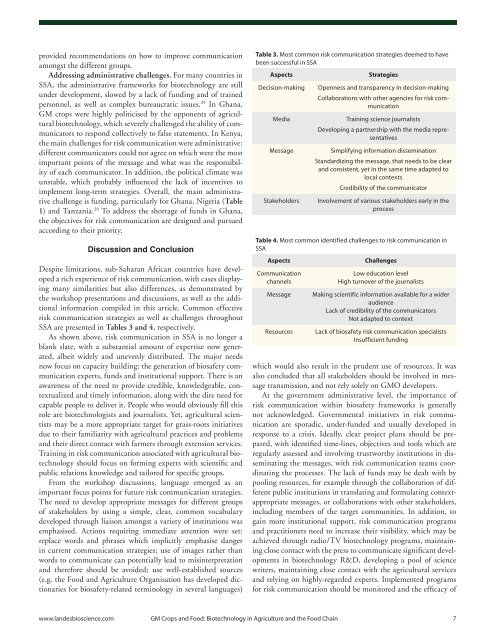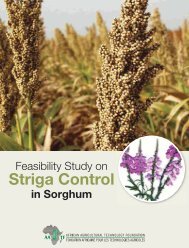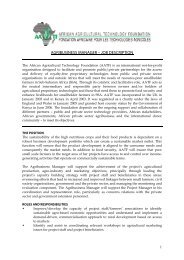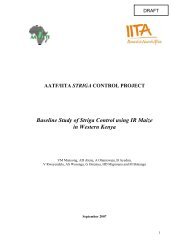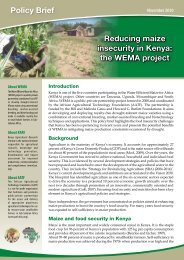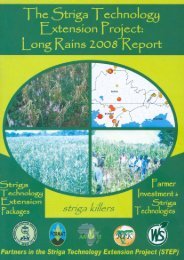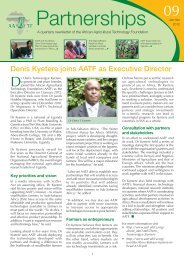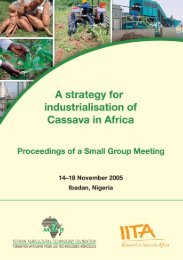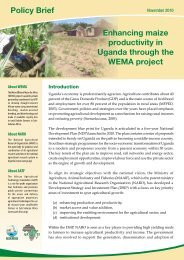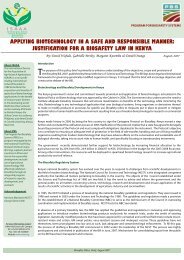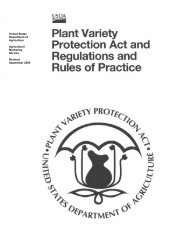Experiences in sub-Saharan Africa with GM crop risk communication
Experiences in sub-Saharan Africa with GM crop risk communication
Experiences in sub-Saharan Africa with GM crop risk communication
You also want an ePaper? Increase the reach of your titles
YUMPU automatically turns print PDFs into web optimized ePapers that Google loves.
provided recommendations on how to improve <strong>communication</strong><br />
amongst the different groups.<br />
Address<strong>in</strong>g adm<strong>in</strong>istrative challenges. For many countries <strong>in</strong><br />
SSA, the adm<strong>in</strong>istrative frameworks for biotechnology are still<br />
under development, slowed by a lack of fund<strong>in</strong>g and of tra<strong>in</strong>ed<br />
personnel, as well as complex bureaucratic issues. 29 In Ghana,<br />
<strong>GM</strong> <strong>crop</strong>s were highly politicised by the opponents of agricultural<br />
biotechnology, which severely challenged the ability of communicators<br />
to respond collectively to false statements. In Kenya,<br />
the ma<strong>in</strong> challenges for <strong>risk</strong> <strong>communication</strong> were adm<strong>in</strong>istrative:<br />
different communicators could not agree on which were the most<br />
important po<strong>in</strong>ts of the message and what was the responsibility<br />
of each communicator. In addition, the political climate was<br />
unstable, which probably <strong>in</strong>fluenced the lack of <strong>in</strong>centives to<br />
implement long-term strategies. Overall, the ma<strong>in</strong> adm<strong>in</strong>istrative<br />
challenge is fund<strong>in</strong>g, particularly for Ghana, Nigeria (Table<br />
1) and Tanzania. 29 To address the shortage of funds <strong>in</strong> Ghana,<br />
the objectives for <strong>risk</strong> <strong>communication</strong> are designed and pursued<br />
accord<strong>in</strong>g to their priority.<br />
Discussion and Conclusion<br />
Despite limitations, <strong>sub</strong>-<strong>Saharan</strong> <strong>Africa</strong>n countries have developed<br />
a rich experience of <strong>risk</strong> <strong>communication</strong>, <strong>with</strong> cases display<strong>in</strong>g<br />
many similarities but also differences, as demonstrated by<br />
the workshop presentations and discussions, as well as the additional<br />
<strong>in</strong>formation compiled <strong>in</strong> this article. Common effective<br />
<strong>risk</strong> <strong>communication</strong> strategies as well as challenges throughout<br />
SSA are presented <strong>in</strong> Tables 3 and 4, respectively.<br />
As shown above, <strong>risk</strong> <strong>communication</strong> <strong>in</strong> SSA is no longer a<br />
blank slate, <strong>with</strong> a <strong>sub</strong>stantial amount of expertise now generated,<br />
albeit widely and unevenly distributed. The major needs<br />
now focus on capacity build<strong>in</strong>g: the generation of biosafety <strong>communication</strong><br />
experts, funds and <strong>in</strong>stitutional support. There is an<br />
awareness of the need to provide credible, knowledgeable, contextualized<br />
and timely <strong>in</strong>formation, along <strong>with</strong> the dire need for<br />
capable people to deliver it. People who would obviously fill this<br />
role are biotechnologists and journalists. Yet, agricultural scientists<br />
may be a more appropriate target for grass-roots <strong>in</strong>itiatives<br />
due to their familiarity <strong>with</strong> agricultural practices and problems<br />
and their direct contact <strong>with</strong> farmers through extension services.<br />
Tra<strong>in</strong><strong>in</strong>g <strong>in</strong> <strong>risk</strong> <strong>communication</strong> associated <strong>with</strong> agricultural biotechnology<br />
should focus on form<strong>in</strong>g experts <strong>with</strong> scientific and<br />
public relations knowledge and tailored for specific groups.<br />
From the workshop discussions, language emerged as an<br />
important focus po<strong>in</strong>ts for future <strong>risk</strong> <strong>communication</strong> strategies.<br />
The need to develop appropriate messages for different groups<br />
of stakeholders by us<strong>in</strong>g a simple, clear, common vocabulary<br />
developed through liaison amongst a variety of <strong>in</strong>stitutions was<br />
emphasised. Actions requir<strong>in</strong>g immediate attention were set:<br />
replace words and phrases which implicitly emphasise danger<br />
<strong>in</strong> current <strong>communication</strong> strategies; use of images rather than<br />
words to communicate can potentially lead to mis<strong>in</strong>terpretation<br />
and therefore should be avoided; use well-established sources<br />
(e.g. the Food and Agriculture Organisation has developed dictionaries<br />
for biosafety-related term<strong>in</strong>ology <strong>in</strong> several languages)<br />
Table 3. Most common <strong>risk</strong> <strong>communication</strong> strategies deemed to have<br />
been successful <strong>in</strong> SSA<br />
Aspects<br />
Decision-mak<strong>in</strong>g<br />
Media<br />
Message<br />
Stakeholders<br />
Table 4. Most common identified challenges to <strong>risk</strong> <strong>communication</strong> <strong>in</strong><br />
SSA<br />
Aspects<br />
Communication<br />
channels<br />
Message<br />
Resources<br />
Strategies<br />
Openness and transparency <strong>in</strong> decision-mak<strong>in</strong>g<br />
Collaborations <strong>with</strong> other agencies for <strong>risk</strong> <strong>communication</strong><br />
Tra<strong>in</strong><strong>in</strong>g science journalists<br />
Develop<strong>in</strong>g a partnership <strong>with</strong> the media representatives<br />
Simplify<strong>in</strong>g <strong>in</strong>formation dissem<strong>in</strong>ation<br />
Standardiz<strong>in</strong>g the message, that needs to be clear<br />
and consistent, yet <strong>in</strong> the same time adapted to<br />
local contexts<br />
Credibility of the communicator<br />
Involvement of various stakeholders early <strong>in</strong> the<br />
process<br />
Challenges<br />
Low education level<br />
High turnover of the journalists<br />
Mak<strong>in</strong>g scientific <strong>in</strong>formation available for a wider<br />
audience<br />
Lack of credibility of the communicators<br />
Not adapted to context<br />
Lack of biosafety <strong>risk</strong> <strong>communication</strong> specialists<br />
Insufficient fund<strong>in</strong>g<br />
which would also result <strong>in</strong> the prudent use of resources. It was<br />
also concluded that all stakeholders should be <strong>in</strong>volved <strong>in</strong> message<br />
transmission, and not rely solely on <strong>GM</strong>O developers.<br />
At the government adm<strong>in</strong>istrative level, the importance of<br />
<strong>risk</strong> <strong>communication</strong> <strong>with</strong><strong>in</strong> biosafety frameworks is generally<br />
not acknowledged. Governmental <strong>in</strong>itiatives <strong>in</strong> <strong>risk</strong> <strong>communication</strong><br />
are sporadic, under-funded and usually developed <strong>in</strong><br />
response to a crisis. Ideally, clear project plans should be prepared,<br />
<strong>with</strong> identified time-l<strong>in</strong>es, objectives and tools which are<br />
regularly assessed and <strong>in</strong>volv<strong>in</strong>g trustworthy <strong>in</strong>stitutions <strong>in</strong> dissem<strong>in</strong>at<strong>in</strong>g<br />
the messages, <strong>with</strong> <strong>risk</strong> <strong>communication</strong> teams coord<strong>in</strong>at<strong>in</strong>g<br />
the processes. The lack of funds may be dealt <strong>with</strong> by<br />
pool<strong>in</strong>g resources, for example through the collaboration of different<br />
public <strong>in</strong>stitutions <strong>in</strong> translat<strong>in</strong>g and formulat<strong>in</strong>g contextappropriate<br />
messages, or collaborations <strong>with</strong> other stakeholders,<br />
<strong>in</strong>clud<strong>in</strong>g members of the target communities. In addition, to<br />
ga<strong>in</strong> more <strong>in</strong>stitutional support, <strong>risk</strong> <strong>communication</strong> programs<br />
and practitioners need to <strong>in</strong>crease their visibility, which may be<br />
achieved through radio/TV biotechnology programs, ma<strong>in</strong>ta<strong>in</strong><strong>in</strong>g<br />
close contact <strong>with</strong> the press to communicate significant developments<br />
<strong>in</strong> biotechnology R&D, develop<strong>in</strong>g a pool of science<br />
writers, ma<strong>in</strong>ta<strong>in</strong><strong>in</strong>g close contact <strong>with</strong> the agricultural services<br />
and rely<strong>in</strong>g on highly-regarded experts. Implemented programs<br />
for <strong>risk</strong> <strong>communication</strong> should be monitored and the efficacy of<br />
www.landesbioscience.com <strong>GM</strong> Crops and Food: Biotechnology <strong>in</strong> Agriculture and the Food Cha<strong>in</strong> 7


